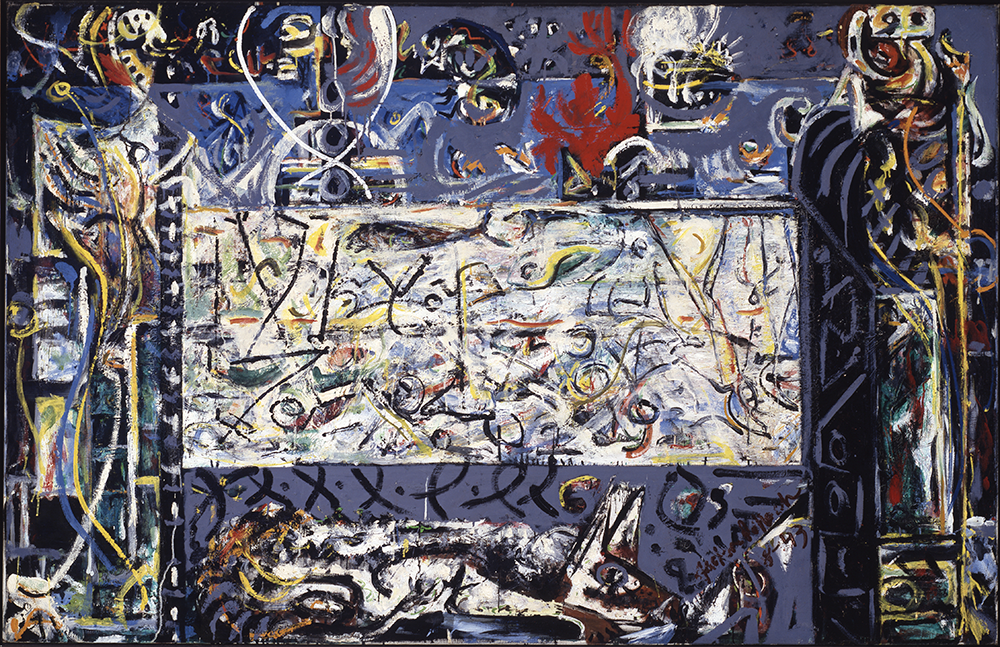The many firsts of SFMOMA
To celebrate the recent addition of nearly 500 images from SFMOMA’s permanent collection to the Artstor Digital Library, Nancy Minty, Artstor’s collections editor, examines more than 80 years of a pioneering institution.
Since 2009, the San Francisco Museum of Modern Art has partnered with Artstor to bring highlights of its collection to our community. The full collection of SFMOMA includes approximately 30,000 works of painting, sculpture, photography, architecture and design, and media arts. It represents artists from the early 20th century onwards, spanning Henri Matisse and Meret Oppenheim in the first decades, through Louise Bourgeois, Dorothea Lange, and Richard Diebenkorn at the century’s midpoint, and on to Sol Lewitt, Robert Rauschenberg, Richard Serra in its later years. Most recently, iconoclasts like Doris Salcedo, Marilyn Minter, and Ai Weiwei have led the collection into the new century
The architectural odyssey of the museum reflects its progressive mandate. Its first autonomous building, opened in 1988, was designed by Swiss architect Mario Botta–brick-clad, postmodern, centered on its signature oculus and accented in black and white stone (prior to 1988, the museum was housed on the top floor of the War Memorial Veterans Building). Last year, the museum expanded its exhibition space threefold when it opened the extension designed by the Norwegian firm Snøhetta–a white building that rises from the neighborhood, cliff-like, striated and undulating, in homage to the famously hilly cityscape of San Francisco, according to the vision of chief architect Craig Dykers.
From its inception, the museum has pioneered innovative exhibitions and acquisitions programs and it is distinguished for its many firsts. In 1935, it opened its doors as the San Francisco Museum of Art (the word Modern was only added to the title in 1975), under the leadership of Dr. Grace McCann Morley (dir. 1935-1958), as the first West Coast museum dedicated to modern art, led by the first woman director in the area. The current director Neal Benezra recognized Morley as the embodiment of the museum’s founding spirit of unconventional innovation: “As we quickly discovered, the legacy is really one of innovation from the get-go… The history of American museums is often one of women trustees hiring male directors… In our case, it was a board of men trustees hiring a female director. It was a very unorthodox history.” 1
Morley, who brought a succession of progressive exhibitions to the museum, began her tenure with a photography show during the inaugural year, “San Francisco Bay Bridge Photographs by Peter Stackpole.” Her prescient recognition of the medium, reinforced by the establishment of a photography collection in 1936, was later fulfilled by Georgia O’Keeffe’s gift (and partial purchase) of 68 photographs from the estate of Alfred Stieglitz in 1952, more recent bequests of the Prentice and Paul Sack Photographic Trust, and the 2016 opening of the Pritzker Center for Photography, the largest gallery and study center for the medium in the country. Two examples from the collection illustrate its depth and excellence in the field of American photography, Stieglitz’s Georgia O’Keeffe, 1920, and Edward Weston’s Sunset (1924).
- Edward Weston, Crepusculo (Sunset), 1924. Image and data from SFMOMA. © 1981 Center for Creative Photography, Arizona Board of Regents / Artist Rights Society (ARS), New York.
Morley’s drive was matched by the generosity of an early patron, Albert Bender, who donated 35 important works to the collection in 1935, including Diego Rivera’s Flower Carrier (1935) and Frida Kahlo’s double portrait of herself with Rivera (1931). Bender, who continued to enrich the museum’s collection, was one of the earliest American supporters of the two Mexican painters, and he was instrumental in bringing them to San Francisco in the early ’30s, where Rivera completed a series of murals. Kahlo’s significance to the museum has endured. In 2008, a retrospective of her work attracted record-breaking crowds.
Under Morley’s direction, many other firsts were achieved. In 1939, she organized the “Twentieth Century German Art (Banned)” exhibition featuring the “degenerate” art that had been rejected by the Nazi regime. The year 1940 marked the first architecture exhibition at the museum, and in 1943 local artist Clyfford Still was honored with his first one-man show. He subsequently gave the museum a series of 28 paintings, including PH-973 (1959). Within ten years, Jackson Pollock was offered his first solo museum showing at SFMOMA, resulting in the purchase of his Guardian of the Secret (1953). Morley also led the museum into the realms of film and TV, with respective series under her supervision.

Jackson Pollock, Guardians of the Secret, 1943. Image and data from SFMOMA. © 2009 Pollock-Krasner Foundation / Artists Rights Society (ARS), New York
SFMOMA remained the nexus for pivotal moments and movements, as, for example, the only West Coast venue of “Contemporary Black Artists,” in 1969, and the debut of Judy Chicago’s Dinner Party in 1979. It persisted as the sole repository of modern and contemporary art on the West Coast through much of the 20th century until MOCA (Museum of Contemporary Art, Los Angeles) opened in 1987.
The museum currently supports the contemporary scene with two enduring programs: New Work (established in 1987), which offers solo exhibitions to promising artists, and the SECA (Society for the Encouragement of Contemporary Art) Art Award, founded in 1967, which nurtures local artists. Marilyn Minter’s Strut (2004-2005) was acquired by the museum after her New Work exhibition in 2005.
Significant acquisitions of the late 20th century include 14 works by Robert Rauschenberg including Port of Entry (1998), bringing the museum’s total by the artist to almost 100 pieces. SFMOMA also became a leading repository of the work of Sol Lewitt in 2000 with a gift of more than 30 works, in addition to earlier acquisitions from the artist.
![Robert Rauschenberg, Captiva, Florida, Port of Entry [Anagram (A Pun)], 1998. Image and data from SFMOMA. © Estate of Robert Rauschenberg / Licensed by VAGA, New York, NY. This work of art is protected by copyright and/or related rights and may not be reproduced in any manner, except as permitted under the Artstor Digital Library Terms and Conditions of Use, without the prior express written authorization of VAGA, 350 Fifth Avenue, Suite 2820, New York, NY 10118. Tel.: 212-736-6666; Fax: 212-736-6767; Email: info@vagarights.com.](https://about.jstor.org/wp-content/uploads/2017/03/asfmomaig_10312704593.png?w=500)
Robert Rauschenberg, Captiva, Florida, Port of Entry [Anagram (A Pun)], 1998. Image and data from SFMOMA. © Estate of Robert Rauschenberg / Licensed by VAGA, New York, NY. This work of art is protected by copyright and/or related rights and may not be reproduced in any manner, except as permitted under the Artstor Digital Library Terms and Conditions of Use, without the prior express written authorization of VAGA, 350 Fifth Avenue, Suite 2820, New York, NY 10118. Tel.: 212-736-6666; Fax: 212-736-6767; Email: info@vagarights.com.
With this new release from SFMOMA, we at Artstor celebrate both the enhancement of our coverage of this dynamic collection and a significant addition to our growing selection of modern and contemporary art. (For other recent contributions to this area, see the collections from the Warhol Foundation, 1, 2 , and the final launch of the Qualls Archive.)
View this collection in the Artstor Digital Library.
1 Scarlet Cheng, “San Francisco Museum of Art turns 75 with a Splash,” LA Times, Jan. 31, 2010
http://articles.latimes.com/2010/jan/31/entertainment/la-ca-sfmoma31-2010jan31
